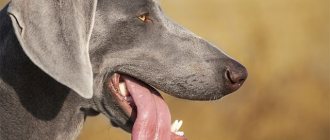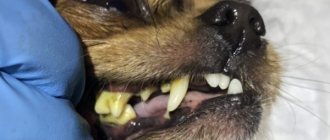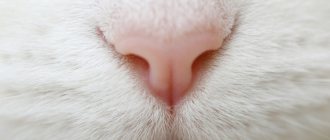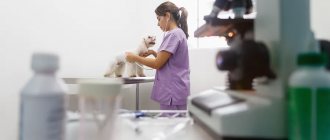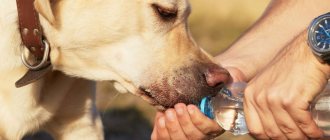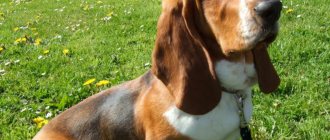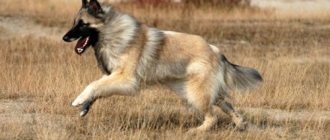If a dog has a cold nose, then its moisture indicates good health. This is quite natural. The sense of smell is the dog’s main receptor, with the help of which it navigates the world around it. It is so strong that the animal can easily detect even a faint odor at a distance of more than 100 meters. Thus, a four-legged pet becomes an excellent assistant for humans, for example, in searching for explosive substances or drugs. The dog's nose simultaneously acts as a respiratory and olfactory organ. In addition, it is a “barometer” in determining the healthy state of the animal.
Anatomy of a dog's olfactory organ
The tip of a dog's nose is always wet and therefore relatively cold. It is covered with mucus secreted by the glands lining the nose. The wet tip of the olfactory organ allows the dog to detect even weak air movements, as well as their direction. After all, we also often dip our finger in salivary fluid and place it vertically to catch the direction of the wind. And in addition to detecting air movements, the layer of liquid on a dog's nose functions like a gas-liquid chromatograph. When molecules of volatile substances that move at different speeds fall on it, the moisture allows them to be separated from each other. Thanks to this, the dog can better distinguish odors. That is, nature made sure that a cold and wet nose helped the dog survive in nature, provide the hunter’s instinct, and smell game and danger. This is how all dogs’ olfactory organs work. They, unlike people’s noses, are covered with moisture inside and out, which allows them to have a good sense of smell.
Most mammal species have wet noses. But the exception to the rule is some of the tarsier primates and real monkeys. When, in the process of evolution, they switched to a diurnal lifestyle, nature relied on their vision as an organ of orientation in space. Their sense of smell has lost its dominant position. The highly sensitive organ of smell simply became unnecessary.
For dogs, smell remains the main way of perception. They recognize their owner and brothers by smell, and with its help they convey a lot of information (territory mark). Therefore, dogs need sensitive noses, and humidity and cold provide just that.
First reason
It's no secret that a dog's sense of smell is thousands of times stronger and better than that of a human. Special glands that cover the dog's nose produce a thin layer of mucus that helps capture the slightest odors, and also acts as a kind of magnet to attract substance molecules - and this significantly improves sensitivity to odors and enhances the sense of smell.
Did you know? The distant ancestors of domestic pets, which are wild dogs and wolves, with the help of their strong sense of smell were able to quickly find prey, which allowed them to survive even in the harshest conditions.
[custom_ads_shortcode2]
Fluid intake norms for an animal
The daily water intake for a dog depends on its weight, physical activity and time of year.
With a fairly active lifestyle in normal, not hot weather, 1 kg of dog’s body weight should include 20-70 ml of clean water per day.
In cases where the dog is undergoing intense training, is in a hot climate, or is ill with an increase in body temperature, the volume of fluid should be increased two to three times.
The daily water intake does not include liquid food and other drinks other than clean drinking water.
The animal needs to drink a certain amount of fluid every day
Anatomical features
The dog's nose is almost always wet and cool. The famous zoologist Knut Schmidt-Nielsen put forward his theory of why dogs have wet noses. He claims that our four-legged friends do not have sweat glands, and a wet nose saves them from overheating.
During rapid breathing in extreme heat, the dog sticks out its tongue, thus increasing cooling. At this time, the nose takes an active part in heat exchange. The mucus that is constantly secreted helps a moist nose to detect odors. Therefore, it is the dog that has an excellent sense of smell, thanks to which it orients itself in space. Naturally, the loss of this opportunity will affect the dog’s behavior.
Dog health and its nose interesting video
There is an opinion that a dog's wet and cold nose indicates its health, while dryness and increased temperature of the olfactory organ may indicate illness. Sometimes this is true, although the nose cannot be considered an ideal indicator of health. Sometimes the nose is dry simply because the dog is hot - after some time its original condition will be restored.
But in other situations, in the presence of accompanying symptoms, a hot, dry nose can indicate a cold; in this case, sneezing and coughing are also observed. Once the dog gets better, its nose will return to normal. A dry nose can also occur with allergic reactions, with nasal pemphigus or injuries - in these cases it is advisable to consult a veterinarian.
Interesting: Life of swallows
If the dog is healthy, a dry nose indicates either dehydration or adverse weather conditions. Not only heat, but also frost leads to its drying out.
Our readers' pets
None to specialist.
Pets are unable to communicate when they feel unwell. But a caring owner can always notice this himself based on various signs. One of the main indicators of a dog’s well-being is the condition of the nasal mucosa.
The mucous membrane can be dry or moist, hot, warm or cool, clean, with ulcers or wounds. All violations indicate that the functions of this organ are not fully performed, and the reason may lie in both pathology and external conditions.
[custom_ads_shortcode3]
What does it mean if a dog has a dry nose?
A dry nose can be completely normal, and some dogs tend to have wetter noses than others. For example, it is very common for sleeping dogs to have warm, dry noses because they are not awake to lick them.
Since the amount of moisture in the nose will vary with humidity and throughout the day, a dog who just woke up from a nap at 2:00 pm with a dry nose may have a wet nose after playing fetch at 7:00 pm. Thus, in most cases, a dry nose in a dog is not automatically a sign of illness.
Sometimes a dry nose can indicate dehydration or fever, but this is usually not the case. If your dog is sick AND has a dry nose, this may be a cause for concern and you should contact your veterinarian.
Third reason
Many owners know that dogs can regulate their body temperature by sticking out their tongues and breathing with their mouths open. This feature of the animal allows it not to sweat. However, every dog sweats quite a lot on its paw pads and, surprisingly, its nose.
This is the third reason why your pet’s nose is constantly wet. That is, a wet nose also serves as a heat exchange tool created by nature itself.
The nose helps the animal cool down when it is too hot, or, conversely, it becomes dry when the dog is cold . Thus, it becomes clear that a dog's health has nothing to do with a wet nose. Some scientists put forward the version that a dog’s thermoregulation is carried out through the nose, and not through the mouth, as was previously believed.
[custom_ads_shortcode1]
When does a dog's dry nose indicate illness?
| Allergy | A dry and warm nose is one of the signs of an allergic reaction to one or more environmental items, as well as inappropriate diet. Additional symptoms include scabies, constant restlessness, dull fur, and frequent shedding. You can identify the allergen by visiting a veterinarian or gradually moving the animal to a new environment with a new diet. |
| Cold | A dry nose during a cold is accompanied by a cough, runny nose, decreased playfulness and the appearance of apathy. Rattles may be heard when barking or breathing. The dog begins to sleep a lot and loses its appetite. Treating animals for colds is very different from the procedures that apply to humans. |
| Apathy | A dry nose combined with a bad mood, apathy and lack of appetite may also indicate the presence of internal trauma. If the condition remains stable for more than 72 hours, but no cause is found, the dog should be taken to the veterinarian. |
| The immune system | A dry nose indicates the presence of pemphigus. This disease is determined visually, as bubbles with liquid appear on the nose, which subsequently dry out and turn into a hard crust. The disease cannot be self-medicated; you must undergo a consultation and get tested at a veterinary clinic. |
| Helminths | Helminths harm not only the animal’s gastrointestinal tract, but also the immune system as a whole. If your pet has a dry nose or a constantly elevated temperature, this indicates a neglected situation. It is urgent to get tested for eggworms, undergo a full course of treatment for helminths, and in the future carry out prophylaxis once every three to four months. |
Also, a dry nose may indicate the presence of plague, rabies, or serious diseases of the internal organs.
If an animal has lost its appetite, interest in games, constantly sleeps, or has a poor appearance, it must be taken to a veterinarian. Further treatment is prescribed depending on the test results.
Exceptions to the rules
Despite the fact that a moist and cool nose is considered normal, there are cases when temporary dryness does not indicate a possible serious illness. If dryness appears for the first time, it is important to pay attention to the following factors:
- After a long sleep, the earlobe is often warmer and drier than usual. It goes away within a few minutes of waking up.
- Allergy. The most common cause of allergic reactions in pet dogs is feeders made of plastic or other materials. The best option is a stainless steel bowl, which almost never causes allergies.
- On the hottest days, the air becomes too dry, which affects both the mucous membranes of dogs and people. The unpleasant sensation will quickly pass after treating the earlobe with water or a weak solution of calendula.
- Insufficient hydration sometimes appears due to injury. It does not necessarily manifest itself externally, but if a dog hits its nose, the functioning of the glands may be disrupted for a short time, after which it will recover on its own.
- After severe physical fatigue, the condition of the mucous membrane may worsen, but as soon as the animal rests, all indicators will return to normal.
- Moral worries and stress affect dogs no less than their owners. The cause of a dry nose is often fear, separation from someone in the household, or other dog troubles. When a puppy moves to a new home, this picture is considered typical. Everything will be restored as soon as the adaptation period ends and the pet gets used to its new place of residence.
In all of the above cases, in a healthy dog, the condition of the nose becomes normal within a short time after the irritating factor is eliminated.
[custom_ads_shortcode2]
Signs of illness that can be detected by a dog's nose
While not every change in your dog's nose requires a visit to the vet, there are times when it might be worth getting it checked out. A dry nose on its own does not necessarily indicate a health problem, but if your dog is experiencing additional symptoms, it is best to contact your veterinarian.
On the other hand, a wet nose and clear nasal discharge are considered normal, but excessive discharge is not. As Lynn Buzhardt explained, if your dog's nose appears runny, thick, or discolored, it's time to head to the vet. “Nasal discharge may indicate respiratory infections or even foreign bodies in the nasal passages,” she wrote.
The skin around your dog's nose can also indicate his health. If it is red, cracked, inflamed, or has open sores, be sure to see a professional.
Types of tonsillitis.
The disease occurs in two forms - acute and chronic. Acute tonsillitis is an illness of an infectious nature and manifests itself in acute inflammation of the tonsil. The cause of exacerbation is staphylococci and streptococci. Acute sore throat in children and adults is also divided into catarrhal, follicular, lacunar, ulcerative-membranous and necrotic.
Chronic tonsillitis is a long-term, persistent inflammatory process in the tonsils. It manifests itself as a consequence of past inflammation, acute respiratory viral infections, dental diseases, and reduced immunity. Chronic exacerbation of the disease in adults and children occurs in three forms: compensated, subcompensated and decompensated. In the compensated form, the disease “dormants”; exacerbation of tonsillitis symptoms occurs infrequently. In the case of a subcompensated form of the disease, exacerbations occur frequently, the disease is severe, and complications are common. The decompensated form is characterized by a long, sluggish course.
Dehydration
Another reason why a dog’s nose suddenly becomes dry is a lack of fluid in the body. These are quite alarming conditions, mild forms of which can develop as a result of insufficient water intake, especially during heat or intense physical activity. Severe dehydration occurs in a number of pathological conditions. For example, with diarrhea, vomiting, excess urine production associated with metabolic disorders.
In case of gastrointestinal disorders accompanied by diarrhea, contractile activity of the intestine increases. Food does not have time to undergo complete digestion, and water is not absorbed by intestinal cells. As a result, the animal’s blood loses part of its liquid fraction, thickens, and blood volume decreases. Blood pressure drops. Everything taken together leads to the fact that organs and tissues do not receive enough nutrients and the oxygen necessary for the functioning of cells.
Dehydration is very dangerous, since with oxygen starvation it is quite possible to develop irreversible changes in various vital organs. Primarily in:
- kidneys;
- pancreas;
- brain.
Irreversible changes are scary because even after normal blood supply is restored, the consequences of the destructive process do not disappear.
If your dog has a cold and dry nose for no apparent reason, you should pay attention to its stool. This is especially true for animals that are not walked on a leash. As a rule, the animal tries to be alone to perform its natural needs, and the owner may simply not know about the pet’s intestinal disorder.
Diarrhea can be caused by many diseases, including viral or bacterial infections that are dangerous for dogs, helminthiases, diseases of internal organs, metabolic disorders, vitamin deficiencies, allergic reactions, and other pathologies.
If a dog’s diarrhea is accompanied by vomiting, which is often observed with poisoning or infections, then dehydration occurs extremely quickly - in addition to the fact that the liquid is not absorbed sufficiently, it simply does not enter the intestines, leaving the animal’s body along with the vomit.
Repeated vomiting is a cause for great concern and an immediate visit to the veterinarian. In such cases, a fatal outcome for the pet is quite possible within 1-2 days.
Non-communicable diseases such as diabetes mellitus and diabetes insipidus can lead to dehydration of the body. The latter is often called diabetes insipidus. Precisely because the pathology is characterized by increased urine output. With such metabolic pathologies, dehydration develops against the background of severe thirst and lack of drinking water.
In conclusion, we can say that there is no single correct answer to the question of why a dog has a warm and dry nose; there can be a lot of reasons for this phenomenon: from completely harmless ones in the form of wind, bright sun or frost to deadly diseases.
In any case, if you notice any health problems with your pet, you should seek advice from a specialist. It is believed that a healthy animal must undergo a preventive examination at least 1-2 times a year.
Equally important for the prevention of various diseases is the creation of comfortable living conditions, the preparation of a competent diet and diet for the animal, timely anthelmintic treatments and vaccinations, which can be combined with an examination of the dog by a veterinarian.
Despite all the sensitivity of the olfactory organ, the main indicator of health problems is not a dog’s wet or dry nose, but its well-being, activity, behavior, and appetite.
Normal condition
In a healthy state, the nose should be cool, because when the temperature rises, the mucous membrane quickly dries out and cannot produce secretions. There is an opinion that if a dog’s nose is hot, and not cold and wet, then the pet is not entirely healthy. However, such a condition does not necessarily indicate the presence of malaise.
Why under some circumstances the nose can be dry - you will learn about this further.
So, puppies have a dry nose both after active pastime and after sleep. Some time after waking up, the nose becomes wet. Sometimes a dog encounters something and the secretion production is disrupted, and as a result, the nose becomes dry.
After a while, secretion production resumes and the condition of the nose will become normal. If the animal is tired, the condition of the mucous membrane worsens. After rest, everything returns to normal.
Related article:
Why does a dog have bloody diarrhea and what to do? The mucous membrane also reacts to stress with dryness. Moving to a new place of residence, fright, saying goodbye to the owner - all this leads to a dry nose. After the dog calms down and gets used to the new conditions, everything will return to normal.
The nose may feel warm in an apartment where the heating is intense. To avoid this situation, the air in the room needs to be humidified. The simplest method is to place a bowl of water in the room or place a wet towel on the radiator.
[custom_ads_shortcode1]

